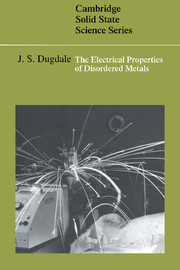Book contents
- Frontmatter
- Contents
- Preface
- 1 Context and content
- 2 Production and structure of metallic glasses
- 3 Electron transport in metals: introduction to conventional theory
- 4 Scattering
- 5 Simple liquid metals: Ziman theory
- 6 Phonons in disordered systems
- 7 Interactions and quasi-particles
- 8 Transition metals and alloys
- 9 The Hall coefficient of metallic glasses
- 10 Magnetoresistance
- 11 Electrical conductivity of metallic glasses: weak localisation
- 12 The interaction effect or Coulomb anomaly
- 13 The effect of the Coulomb interaction on conductivity
- 14 Influence of a magnetic field on the enhanced interaction effect
- 15 The thermopower of metals and alloys
- 16 Comparison with experiment
- Appendices
- Notes
- References
- Index
2 - Production and structure of metallic glasses
Published online by Cambridge University Press: 21 January 2010
- Frontmatter
- Contents
- Preface
- 1 Context and content
- 2 Production and structure of metallic glasses
- 3 Electron transport in metals: introduction to conventional theory
- 4 Scattering
- 5 Simple liquid metals: Ziman theory
- 6 Phonons in disordered systems
- 7 Interactions and quasi-particles
- 8 Transition metals and alloys
- 9 The Hall coefficient of metallic glasses
- 10 Magnetoresistance
- 11 Electrical conductivity of metallic glasses: weak localisation
- 12 The interaction effect or Coulomb anomaly
- 13 The effect of the Coulomb interaction on conductivity
- 14 Influence of a magnetic field on the enhanced interaction effect
- 15 The thermopower of metals and alloys
- 16 Comparison with experiment
- Appendices
- Notes
- References
- Index
Summary
What are metallic glasses?
The word ‘glass’ as we normally use it refers to window glass. As we all know, this is a brittle, transparent material with vanishingly small electrical conductivity. It is in fact a material in which the constituent molecules are arranged in a disordered fashion as in a liquid but not moving around; that is to say, each molecule keeps its same neighbours and the glass behaves like a solid. Most of the solids that physicists have hitherto dealt with are crystalline i.e. their atoms or molecules are arranged in strictly ordered arrays. This is the essential difference between a so-called ‘glass’ and a crystal: a glass has no long-range order. Although the word ‘glass’ was originally used to designate only window glass it has now taken on this generalised meaning of what we may call an amorphous solid.
Electrically insulating glasses have been studied for a long time and it was generally thought that in order to form a glass by cooling a liquid it was necessary to have a material composed of fairly complicated molecules so that, on cooling through the temperature range at which crystallisation would be expected to occur, the molecules would have difficulty in getting into their proper places and could be, as it were, frozen in a disordered pattern at lower temperatures without the thermal energy necessary to get into their ordered positions. This general picture is correct and helpful although the expectations based on it have proved in some respects wrong. It was thought that because metals and alloys are usually of simple atoms, it would be impossible to form a glass from such constituents.
- Type
- Chapter
- Information
- The Electrical Properties of Disordered Metals , pp. 6 - 19Publisher: Cambridge University PressPrint publication year: 1995



